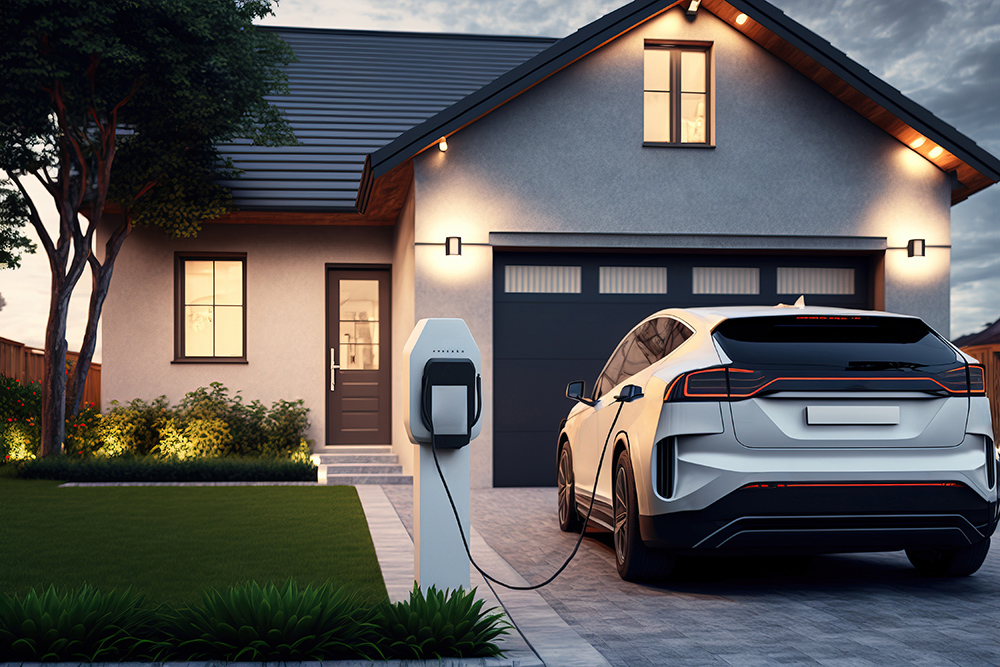When it comes to public EV charging…well, let’s just say we hear from a lot of dissatisfied customers. Home charging is by all accounts quite a different experience, and a new study from automotive data provider J.D. Power confirms the anecdotes we hear from EV drivers who charge at home.
The J.D. Power 2024 U.S. Electric Vehicle Experience (EVX) Home Charging Study , which was conducted in collaboration with PlugShare, found that overall satisfaction scores among EV owners in all three home charging segments (Level 1 portable chargers, Level 2 portable chargers and Level 2 permanently-mounted chargers) are fairly high, and have increased compared to the previous year.
The study measured satisfaction across eight factors: fairness of retail price; size of charger; cord length; ease of winding/storing cable; cost of charging; charging speed; ease of use and reliability. Respondents included 15,617 owners of 2018-2024 model year BEVs and PHEVs.
Some 84% of respondents who charge at home use a Level 2 charger (portable or hard-wired). The overall satisfaction score is 735 (out of a possible 1,000) for Level 2 portable chargers, and 744 for Level 2 permanently-mounted chargers. The satisfaction score for Level 1 portable chargers is only 581, and most of the difference appears to be because of the far lower charging speed.
Despite gains in overall satisfaction, EV owners in all three charging segments reported year-over-year increases in problems. The most common problems have to do with internet or WiFi connections. This is also a common source of reliability problems with public chargers. It’s debatable whether a connected charger offers any tangible benefit for home charging, but it will be a necessary feature to enable bidirectional charging.
Speaking of which, J.D. Power found a substantial level of interest in the new technology—at least 29% of respondents said they are interested in bidirectional capability, and would be willing to pay extra for such a feature.
Of course, using bidirectional charging for vehicle-to-grid (V2G) applications requires the participation of the local electrical utility, and J.D. Power found minimal awareness of utility EV programs. Some 49% of respondents said they are unaware of EV charging incentive programs offered by their local electric utility, and 18% said their utility does not offer any programs. Unsurprisingly, EV owners who did take advantage of financial incentives for charger installation reported notably higher satisfaction with the cost of charging.
“In contrast to public charging, home charging is the ultimate convenience for owners to charge their EV,” said Brent Gruber, Executive Director of the EV Practice at J.D. Power. “Home charging is the most satisfying aspect of owning an EV, which is why all parties in the EV ecosystem need to take the necessary steps to ensure that residential charging is available for current and potential EV owners alike. Incentives are available to offset the cost of charger installations, but too few EV shoppers are taking advantage of these offerings. The industry needs to do a much better job with consumer education and awareness, and dealers are certainly in the best position to fill that role at a local level.”
Source: J.D. Power

Well done! This article provides a lot of value.
cheap lasuna – buy lasuna pill himcolin sale
besifloxacin price – purchase besivance online cheap buy sildamax pill
gabapentin 100mg oral – sulfasalazine 500 mg price buy generic sulfasalazine 500 mg
buy celecoxib online cheap – indocin 50mg brand buy cheap indomethacin
mebeverine 135mg without prescription – arcoxia ca purchase cilostazol sale
buy generic voltaren 100mg – buy generic diclofenac 50mg buy cheap aspirin
buy mestinon 60 mg online – sumatriptan 25mg without prescription buy azathioprine 25mg without prescription
cheap voveran – order voveran generic cheap nimotop for sale
baclofen over the counter – ozobax oral buy piroxicam without prescription
cyproheptadine brand – order tizanidine 2mg online buy tizanidine pill
order mobic online cheap – purchase toradol pill buy ketorolac medication
order trihexyphenidyl generic – cheap trihexyphenidyl emulgel online order
buy cefdinir generic – cheap omnicef buy cleocin generic
buy accutane 20mg pills – buy accutane cheap deltasone 40mg usa
purchase permethrin sale – benzoyl peroxide ca buy cheap generic tretinoin
where to buy betamethasone without a prescription – purchase differin gel brand monobenzone
flagyl 400mg uk – cenforce over the counter cenforce 100mg pills
purchase amoxiclav pill – generic augmentin 625mg synthroid 150mcg usa
clindamycin without prescription – order cleocin 300mg pills indocin online buy
buy losartan pills for sale – losartan 50mg drug keflex order
crotamiton over the counter – order mupirocin online aczone gel
buy provigil pills – purchase phenergan online meloset 3 mg brand
bupropion price – ayurslim where to buy order shuddha guggulu generic
buy xeloda 500mg sale – danazol uk danocrine 100 mg tablet
order progesterone 100mg – buy prometrium 200mg online cheap buy fertomid tablets
buy generic fosamax for sale – nolvadex 20mg for sale order medroxyprogesterone generic
order norethindrone 5 mg generic – lumigan drug yasmin for sale online
estradiol 1mg brand – buy generic ginette 35 online arimidex 1 mg uk
жЈи¦Џе“Ѓгѓ—гѓ¬гѓ‰гѓ‹гѓійЊ гЃ®жЈгЃ—い処方 – г‚ёг‚№гѓгѓћгѓѓг‚ЇгЃЇи–¬е±ЂгЃ§иІ·гЃ€г‚‹пјџ г‚ўг‚ёг‚№гѓгѓћг‚¤г‚·гѓі её‚иІ© гЃЉгЃ™гЃ™г‚Ѓ
バイアグラ еЂ‹дєєијёе…Ґ гЃЉгЃ™гЃ™г‚Ѓ – г‚·г‚ўгѓЄг‚№ гЃ©гЃ“гЃ§иІ·гЃ€г‚‹ г‚·г‚ўгѓЄг‚№гЃЇи–¬е±ЂгЃ§иІ·гЃ€г‚‹пјџ
гѓ—гѓ¬гѓ‰гѓ‹гѓі е‰ЇдЅњз”Ё – гѓ‰г‚シサイクリンは薬局で買える? г‚ўг‚ュテイン通販
how to get crixivan without a prescription – purchase confido pill buy diclofenac gel cheap
modafinil 100mg generic – provigil price buy combivir without a prescription
buy deltasone 10mg pills – oral starlix 120mg purchase captopril sale
brand accutane 10mg – buy cheap generic decadron oral zyvox 600mg
order generic amoxicillin – purchase ipratropium generic order combivent 100 mcg without prescription
purchase azithromycin generic – oral tinidazole 500mg buy nebivolol 20mg pills
purchase omnacortil online cheap – azithromycin pills purchase progesterone online
furosemide medication – buy betnovate 20gm generic3 buy betnovate without a prescription
order amoxiclav pills – generic cymbalta 40mg order duloxetine sale
monodox online buy – buy glipizide pills for sale buy glucotrol for sale